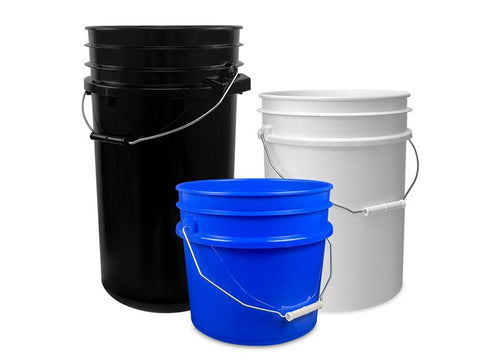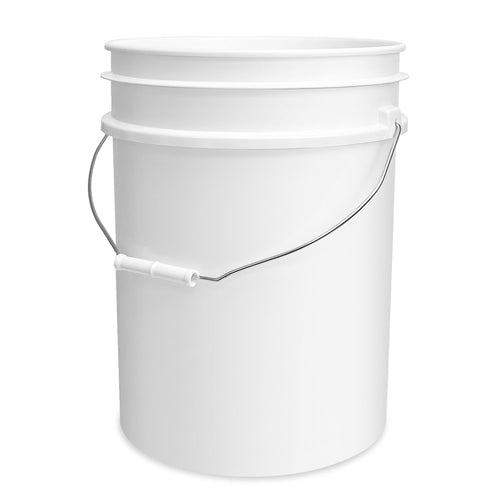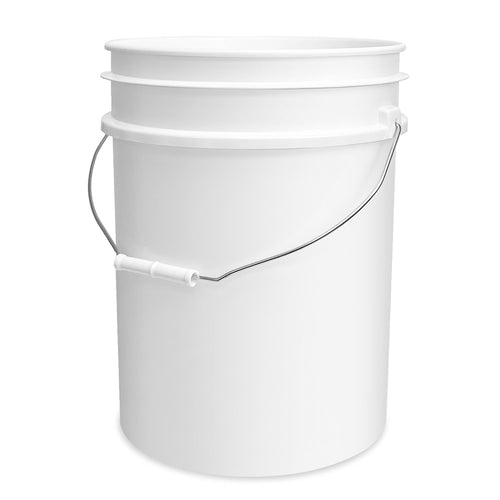When it comes to food storage and packaging, understanding FDA compliance for plastics can be confusing. Many consumers and businesses believe that plastic containers must explicitly say "food safe" to be compliant, but this common misconception can lead to unnecessary confusion and costs. This guide clarifies what FDA compliance actually means, what labeling is (and isn't) required in the United States, and how to identify truly food-safe plastics for your buckets, food containers, and storage needs.
Let's separate fact from fiction when it comes to food-safe plastic requirements in the United States.
Explore Our FDA-Compliant Storage Solutions
All our food storage products meet FDA standards for food contact applications.
The Big Misconception: "Food Safe" Labeling Requirements
Here's a truth that might surprise you: In the United States, plastic containers are NOT required to be labeled "food safe" to be compliant with FDA standards. This widespread misconception causes confusion for consumers and businesses alike.
Key Point: What matters for food safety is whether the material itself meets FDA standards for food contact—not whether the product carries a "food safe" label. Many FDA-compliant plastics carry no special marking at all.
This misconception likely stems from consumer products where such labeling is more common as a marketing practice, not a regulatory requirement. In reality, the vast majority of food-safe plastics used in commercial and industrial applications carry no visible food-safety markings.
FDA Compliance vs. "FDA Approved": Understanding the Difference
Another common source of confusion is the difference between FDA compliance and FDA approval. Let's clarify these important distinctions:
What FDA Compliance Actually Means
FDA compliance means that the plastic material meets the FDA's standards for food contact as outlined in the Code of Federal Regulations (CFR), specifically Title 21. These regulations specify:
- Which raw materials and additives can be used in plastics intended for food contact
- Maximum levels of certain substances that might migrate from the plastic to food
- Testing requirements to ensure safety under intended use conditions
- Good manufacturing practices for food contact materials
Manufacturers are responsible for ensuring their materials comply with these regulations. They don't need to submit each product to the FDA for review or receive an "approval stamp."
You can review the FDA's food contact substance regulations directly at FDA.gov's Food Contact Substances page and the specific regulations in 21 CFR Parts 170-199.
Why "FDA Approved" Can Be Misleading
The term "FDA approved" is often misused in marketing materials. The FDA doesn't "approve" individual plastic products for food contact in the way they approve medications or medical devices. Instead:
The Reality of FDA Oversight:
- The FDA establishes regulations for food contact materials
- Manufacturers must ensure their products comply with these regulations
- The FDA doesn't individually review or "approve" each plastic container
- Companies may conduct their own testing or rely on supplier certifications
- The FDA can take enforcement action if products are found to be non-compliant
Quick Tip: When a supplier says their products are "FDA compliant" or "meet FDA standards," this is typically more accurate than claiming products are "FDA approved."
The Fork and Glass Symbol: A European Standard, Not American
You may have seen a symbol showing a wine glass and fork on some plastic containers. Many people assume this is a universal food safety indicator, but it's actually specific to European regulations.
Understanding International Food Contact Symbols
EU Food Contact Symbol: Required in the European Union for materials intended for food contact
US Requirements: No such symbol required for FDA-compliant materials
The absence of this symbol on U.S. products does NOT indicate the product isn't food-safe
This symbol is mandated by European Union Regulation (EC) No 1935/2004 for food contact materials sold in Europe. In the United States:
- There is no requirement to use this or any similar symbol
- Most U.S.-manufactured food-safe plastics won't display it
- Its presence or absence says nothing about FDA compliance
- Some products sold in both markets might include it, but it's not a U.S. requirement
Why Most Food-Safe Plastics Don't Carry Visible Markings
This might surprise you: the vast majority of FDA-compliant, food-safe plastics in the United States carry no special markings or labels indicating their food safety status. This is especially true for:
Bulk and B2B Products
Industrial and commercial food-safe plastics, like our 5-gallon buckets, rarely carry consumer-facing labels because:
- They're sold to businesses who verify compliance through documentation
- Adding labels to every item would increase costs unnecessarily
- Professional users rely on specifications and certificates, not visual markers
- Many items are further processed or repackaged before reaching end users
Cost and Practical Considerations
Requiring visible markings on every food-safe plastic item would be impractical because:
- It would add manufacturing steps and costs
- Many items are too small for legible markings
- Some manufacturing processes make permanent marking difficult
- The regulatory focus is on material safety, not labeling
Remember: The absence of a "food safe" label or symbol doesn't mean a plastic isn't safe for food contact. What matters is the material composition and manufacturing process, not the presence of a label.
What "Food-Safe" Really Means: Material Performance Under Normal Use
When we say a plastic is "food-safe," we're referring to the material's performance characteristics under normal, intended use conditions. This means:
Food-Safe Material Characteristics:
- Chemical Stability: The plastic won't break down or release harmful chemicals into food under normal storage conditions
- Migration Limits: Any substances that might transfer from the plastic to food are within safe limits established by the FDA
- Temperature Resistance: The material performs safely within its intended temperature range
- Non-Toxic Composition: Made from FDA-approved polymers and additives
- Appropriate for Intended Use: Different plastics are suitable for different applications (hot foods, acidic foods, long-term storage, etc.)
It's important to understand that "food-safe" doesn't mean:
- The FDA has individually tested and approved that specific product
- The plastic is suitable for ALL food contact applications
- The material will never degrade (all plastics have limitations)
- It's safe to use beyond its intended purpose (e.g., microwaving non-microwave-safe containers)
Where You WILL See Food-Safety Indicators
While not required, you're more likely to see food-safety indicators on certain consumer products:
Common Places for Food-Safety Markings
Consumer Products Often Displaying Indicators:
Deli Containers and Take-Out Packaging
Often marked with recycling codes and sometimes temperature limits
Yogurt Cups and Dairy Containers
May include recycling symbols and occasionally microwave-safe indicators
Beverage Bottles
Almost always show recycling codes, sometimes with additional safety information
Microwave-Safe Containers
Usually marked with microwave-safe symbols and temperature guidelines
Storage Containers for Retail Sale
Consumer storage products often include "BPA-free" or "food-safe" as marketing features
Why These Products Are More Likely to Be Marked
Consumer-facing products are more likely to display food-safety information because:
- Marketing differentiation in competitive retail environments
- Consumer education and confidence building
- Specific use instructions (microwave-safe, freezer-safe, etc.)
- Brand reputation and liability considerations
How to Verify Food Safety for Your Plastic Products
Given that most food-safe plastics won't carry visible markings, how can you ensure the products you're using are safe for food contact?
For Business Purchases
- Request Documentation: Ask suppliers for FDA compliance statements or certificates
- Verify Material Type: Confirm the plastic resin used (HDPE, PP, PET, etc.)
- Check Specifications: Review technical data sheets for food contact compliance
- Work with Reputable Suppliers: Established suppliers will readily provide compliance information
At ePackageSupply, we're always happy to provide documentation of food-safe certifications from our manufacturers. Simply contact our team, and we'll share the relevant compliance certificates for any of our food storage buckets or containers.
For Consumer Purchases
- Check Product Descriptions: Online and packaging should indicate food safety
- Look for Recycling Codes: Numbers 1, 2, 4, and 5 are generally food-safe plastics (learn more in our Plastics 101 guide)
- Buy from Trusted Sources: Reputable retailers typically sell compliant products
- Contact Manufacturers: When in doubt, reach out directly for confirmation
Pro Tip: If a supplier can't or won't provide FDA compliance documentation for products intended for food use, consider finding another supplier who can.
The Bottom Line: Don't Let Labeling Myths Guide Your Decisions
Understanding FDA compliance for food-safe plastics doesn't have to be complicated once you know the facts. The key takeaways are:
Key Facts About Food-Safe Plastics in the U.S.
- No labeling requirement exists for food-safe plastics in the United States
- The absence of "food safe" labels or symbols doesn't indicate non-compliance
- FDA compliance refers to material standards, not individual product approvals
- The fork and glass symbol is a European requirement, not American
- Most bulk and B2B food-safe plastics carry no special markings
- "Food-safe" means the material performs safely under intended use conditions
- Verification comes through documentation and specifications, not visual inspection
- Consumer products are more likely to show markings for marketing reasons
At ePackageSupply, all our food storage products meet FDA standards for food contact, regardless of whether they carry visible markings. We maintain comprehensive compliance documentation from our manufacturers and are always happy to provide verification for any of our products—just ask! Whether you need food-grade buckets or food containers, don't let labeling misconceptions prevent you from accessing quality, cost-effective options.
Questions About FDA Compliance?
Our team can provide documentation and answer any questions about our food-safe products.

 Violet Zhang
Violet Zhang
















































